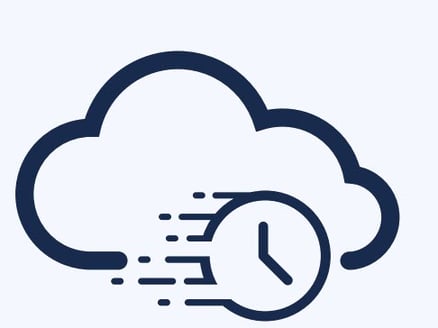TECHNOLOGY INTEGRATIONS
& PARTNERSHIPS
- Atlassian
- AWS
- Appfire
- Tempo
- Carahsoft
- ...and more!
In an effort to gain greater business agility, more organizations than ever are undertaking or accelerating their digital transformation initiatives. In fact, in a 2022 PWC Pulse Survey of C-suite executives, 60% of them indicated that digital transformation is their most critical growth driver, and in November 2021, IDC forecast that digital transformation expenditure would continue its trajectory of rapid growth. As part of this digital transformation, more organizations are migrating their software solutions to the cloud, and Atlassian customers are no exception.
Atlassian recognizes that the future of work is in the cloud, and that’s where the company is focusing the vast majority of its R&D efforts. Atlassian Cloud offers a number of key benefits, including:
One of the primary advantages of the Atlassian platform is its extensibility. While the native functionality in Atlassian Cloud products is already robust—and constantly advancing—the company recognizes the value that its more than 1,000 Marketplace partners bring to its customer base. One significant way Atlassian is investing in Cloud is through its purpose-built Cloud development platform, Forge. Forge is designed to streamline and simplify app development, so that third-party Marketplace vendors can quickly, easily, and securely innovate, and their Cloud customers can benefit from that innovation.
Since Atlassian hosts the code for Forge apps, it means the apps are more tightly integrated with the company’s core products, so they run faster and with fewer issues. It also means they come with the same enterprise-grade security that Atlassian Cloud does.
Just as the future of work is in the cloud, the future of Atlassian apps is in Forge, and it is likely where the greatest app innovation will be found.
Another reason to prioritize migration to Atlassian Cloud is that support for Server will end on February 15, 2024. (The company stopped selling new licenses and ceased feature development on February 2, 2021.) According to the company’s website, after that date, “Atlassian and Marketplace Partners will no longer provide technical support for any issues, security updates, or bug fixes for critical vulnerabilities.” So, while you could technically continue to run on Server, the risks would be extremely high.
Organizations currently on Server must make a move, and while many will choose Cloud, Atlassian is continuing to invest in and support its Data Center deployment option for the limited business use cases in which it is necessary.
We should note at this point that regardless of whether your organization migrates directly from Server to Cloud, or determines that migration to Data Center is a necessary interim step, timing is critical, even urgent, especially for larger organizations. Evaluating your instance, determining the best path forward, and actually migrating is a process typically measured in months—and for some of the largest or most complex migrations, it can be years. Additionally, as the Server end-of-life date draws near and more companies act, experienced resources with availability to support migration may become increasingly challenging to find.
The time to act is now!

If you are currently an Atlassian Server customer, migrating to either Cloud or Data Center is a business imperative. However, in our experience at Isos Technology, Cloud is the most desirable and sustainable long-term option, and in almost all cases, perceived barriers can be overcome.
In this next section, we will explore the high-level differences between Cloud and Data Center, as well as the reasons why an organization might choose one over the other.
Atlassian Cloud is a true software-as-a-service (SaaS) product, and like all SaaS software providers, Atlassian does the bulk of the heavy lifting in terms of managing and updating the platform. This means that organizations that migrate to Atlassian Cloud are free from the burden of self-managing both their servers and their tools, although they may still need admins, and can focus innovation within their own businesses.
Atlassian uses Amazon Web Services as its Cloud provider, so the company is able to take full advantage of AWS redundancy capabilities. Your data is further protected by AWS’ industry-leading data center security protocols and Atlassian’s own enterprise-level cloud security practices.
Atlassian’s four Cloud tiers mean there is a solution for virtually every company, from the smallest startup to the largest enterprise. More than 90% of new Atlassian customers choose Cloud, and many existing customers migrate to Cloud as part of their overarching digital transformation initiatives, as well as to better support business agility. These organizations stand to benefit from improved innovation and team collaboration, reduced operational, IT, and hardware costs, and built-in security, privacy, compliance, and reliability.
To learn more about Atlassian Cloud’s four tiers (Free, Standard, Premium, and Enterprise) read our whitepaper: The Demystification of Atlassian Cloud: How to Choose the Right Plan for Your Organization.
Atlassian Data Center remains a strong, reliable product, and like Server, it is self-managed, so you would need to host your Atlassian tools on your own infrastructure or through third-party cloud providers like AWS or Azure. As with Server, an internal team would continue to be needed to manage the software, although if bandwidth or skillset is a concern, you might be able to supplement that with managed services.
There are two primary reasons an organization might choose to migrate from Server to Data Center. The first reason is that your organization must meet a regulatory standard that Atlassian Cloud is not yet compliant with, or does not have on the roadmap for compliance prior to end of support for Server. The second reason is that regulatory requirements mandate that your organization’s data must remain in a self-managed environment.
If you need to migrate to Data Center as an interim step, but have a longer-term plan to migrate to Cloud, you should note that Data Center incorporates some features that help optimize data to streamline bringing it to Cloud when you are ready.
For a point-by-point comparison of the two products, read Atlassian’s Compare Atlassian Cloud and Data Center page on its website.
We see three primary areas of concern that cause organizations to postpone migrations to Atlassian Cloud: security and compliance, application feature and functionality parity, and cost concerns.
In migrating to Cloud, security, compliance, and data residency concerns are always top priority, and rightfully so. These can be some of the strongest sticking points, and we have grouped them together because companies typically must undertake their own, independent research to determine if Cloud is right for them. Fortunately, Atlassian simplifies this research by making all the necessary information available in its Trust Center.
Find detailed information about compliance on the Atlassian Trust Center compliance page.
Find detailed information about data residency on the Atlassian data residency page.
Find detailed information about security on the Atlassian Trust Center security page.
Since Atlassian Cloud’s web-based architecture is fundamentally different from Server and Data Center, Atlassian and its Marketplace vendors must build Cloud versions of their apps from the ground up, which has advantages and disadvantages. On the plus side, the redesigned apps can take full advantage of Cloud infrastructure, with tighter integration and improved functionality. However,
vendors may not have built Cloud versions of their apps yet, or the apps that have been built might not have feature and functionality parity.
When organizations migrate to Cloud, however, their processes often evolve, making some apps unnecessary, or at least not as critical. Additionally, new apps in Cloud may offer increased functionality, replacing multiple on-prem apps that were needed previously. It is even possible that some of the functionality an organization previously used apps to solve for will be native in Cloud versions of Atlassian tools like Confluence and Jira. Another option also exists—Atlassian Solution Partners like Isos Technology may be able to offer custom scripting solutions to bridge any feature gaps.
The big takeaway here is this: it may take some ingenuity and effort, but the vast majority of parity issues can be resolved.
To learn more about migrating third-party apps, read our whitepaper: Migrating to Atlassian Cloud? Seven Key Decisions to Make about Apps.
To learn more about migrating ScriptRunner, read our whitepaper: The Essential Guide to Migrating to ScriptRunner for Jira Cloud.
The upfront costs associated with a migration to Atlassian Cloud can be substantial, and while they need to be planned and budgeted for, they are only part of the equation. Organizations planning to migrate should consider the total cost of ownership—the upfront migration costs relative to the long-term, quantifiable savings and other non-quantifiable economic benefits of investing in Cloud.
The total cost of ownership, including both the hard costs related to migration and the savings incurred post-migration, varies broadly from organization to organization. Atlassian has some excellent tools on its website to help companies estimate Cloud licensing fees. At Isos Technology, we also make it a practice to provide a Total Cost of Ownership Analysis™ as part of our estimating process. This helps our clients gauge what their expenses related to Atlassian may be for the first few years after the migration, and when they might begin realizing a return on investment.
To help organizations understand the financial impact of migrating to Atlassian Cloud, Atlassian commissioned a Forrester report, The Total Economic Impact of Atlassian Cloud. In this report, actual migration costs and subsequent savings for four Atlassian customers are aggregated in a composite organization that achieved 155% ROI and $1.79M in savings with a payback period of only 6 months by migrating to Atlassian Cloud.
Savings came from a reduction in Atlassian licensing fees due to improved user management, a reduction in third-party app licensing fees due to app consolidation and enhanced native Cloud functionality, a reduction in hardware and hardware maintenance fees, an increase in workforce productivity, and a reduction of labor associated with Atlassian administrators.
To learn more about the economic impact of migrating to Atlassian Cloud, read the whitepaper: The True Cost of Migrating to Atlassian Cloud.
Migrations can be complex, even for small organizations, and there is always some risk involved, so most organizations will benefit from working with an Atlassian Solution Partner. While many organizations have talented Atlassian administrators on staff, they may not have the specialized skills or experience in migrations specifically. Bandwidth is also an issue—a migration is a significant undertaking that could take a group of admins away from their daily responsibilities for a long period of time.
In addition, given the scope of the undertaking and the mission-critical nature of the tools, no business can afford to have a migration go wrong, and there are plenty of things that can happen—unforeseen delays, loss of data, or a solution that is poorly architected, among others. An Atlassian Solution Partner like Isos Technology will have hundreds of successful migrations under its belt, and experience and expertise working with customers across a broad range of industries and company sizes. We also have proprietary tools for overcoming challenging migration scenarios.

Isos Technology has an eight-step process for migrations, with many of these activities happening concurrently or overlapping—it’s not necessarily a linear process. Here’s what to expect:
Additionally, Isos can help you bring the right people into the conversation at the right time, and ensure their input is heard and/or they get the information they need. For example, your security and compliance teams will need to be brought in very early in the evaluation process, so that their concerns can be addressed and any necessary documentation can be obtained. Other important considerations that an Atlassian Solution Partner can help with are change management and training to ensure all users are prepared to use the new system, and that it is rapidly adopted with the least amount of disruption to your organization.
To learn more about Isos Technology’s migration process, read our whitepaper: How to Migrate to Atlassian Cloud in Eight Steps.
Next Steps – Resources for Learning More About Atlassian Cloud Migration
If you are considering a migration from Server to Atlassian Cloud or Data Center, looking to merge multiple instances in Cloud, or want to right-size your current Atlassian Cloud offering, we encourage you to reach out to us. We understand that no organization’s needs are the same—our team of experts can provide the strategic guidance necessary to align your Cloud instance with your long-term business strategy, architect your system, clean up your instance, migrate your data using both Atlassian and proprietary tools, and train your admins and users to be up-and-running on day one.

Isos Technology is an Atlassian Platinum and Enterprise Solution Partner with a Cloud specialization, and an Atlassian Partner of the Year in both the ITSM and Enterprise categories. We accelerate the innovation curve for the companies that are changing the world. How can we help you achieve your goals?
Explore General Atlassian Cloud Resources
Explore Atlassian’s Cloud Migration Resources
Explore Atlassian’s Migration Cost Calculator and Forrester Economic Impact Report
Explore Isos Technology’s Cloud Resources